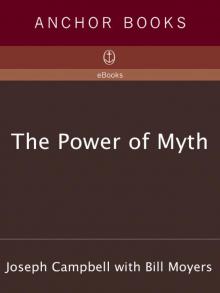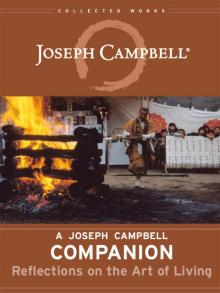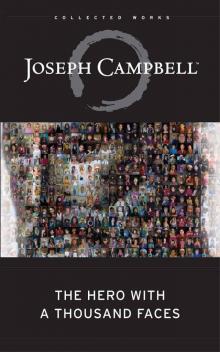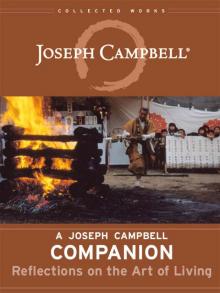- Home
- Joseph Campbell
A Joseph Campbell Companion: Reflections on the Art of Living
A Joseph Campbell Companion: Reflections on the Art of Living Read online
A Joseph Campbell Companion:
Reflections on the Art of Living
Edited by Robert Walter
Conceived by Diane K. Osbon
THE COLLECTED WORKS OF JOSEPH CAMPBELL
Copyright Notice
A Joseph Campbell Companion:
Reflections on the Art of Living
Copyright 1991, Joseph Campbell Foundation (JCF.org)
This electronic edition, copyright © 2011, Joseph Campbell Foundation
Published by Joseph Campbell Foundation
Cover art: Photograph by Joseph Campbell; copyright © 2003, 2011, Joseph Campbell Foundation
All rights reserved.
No part of this work may be reproduced or transmitted in any form or by any means, electronic or mechanical, including photocopying, recording, or by any information storage and retrieval system, without permission in writing from Joseph Campbell Foundation. To quote from or reprint sections of this book, contact JCF at [email protected]
For information about this edition, see the Foreword.
Ebook by
tillpoint Digital Press
Thank you for maintaining this ebook for your personal use.
If you have received this book gratis, please join the JCF's associates in supporting our on-going efforts to bring out new, inspiring editions such as this by making a donation at JCF.org.
The Joseph Campbell Foundation is a registered 501(c) 3 United States not-for-profit corporation.
For further information, contact us on our website (www.jcf.org) or at the following address:
Joseph Campbell Foundation
Post Office Box 36
San Anselmo CA 94979-0036
United States of America
ISBN 978-1-61178-006-2
Table of Contents
Foreword
In the Field
Living in the World
Coming into Awareness
Living in the Sacred
About the Collected Works of Joseph Campbell
About Joseph Campbell
About Joseph Campbell Foundation
Foreword to the Electronic Edition
WELCOME to the first electronic edition of one of Joseph Campbell's most popular works. A Joseph Campbell Companion: Reflections on the Art of Living has long been one of our favorite Campbell titles, and it is perennially one of this quotable man's most quoted.
This book was drawn from transcripts of a month-long series of workshops that Joseph Campbell gave at the Esalen Institute in Big Sur, California in March, 1984—the year of his eightieth birthday. The idea for the book was conceived by workshop attendee Diane K. Osbon in 1990, some three years after Campbell died. The text was edited into its present form by longtime Campbell editor and JCF president Robert Walter.
Filmed segments from this same month-long celebration of Campbell and his work are available in The Hero's Journey, which is available as part of the Collected Works of Joseph Cambpell series in both video and print formats.
A Joseph Campbell Companion was originally published by HarperCollins in 1991. In addition to this edition, the book is currently available in a paperback edition published by HarperPerennial.
This electronic edition was published in August, 2011. It contains the complete text of the original print edition, with some minor changes in style and spelling, except for an introduction to the print edition, which has been omitted.
The photograph used in the cover art of a yamabushi conducting a Shintō fire ceremony was taken by Joseph Campbell in Kyōto, Japan in 1956.
Campbell intended that his essays spark thought and discussion. To comment or discuss this book locally, we encourage you to find one of our local Mythological RoundTable® groups, meeting regularly in small towns and big cities around the globe. To discuss mythology, psychology, religion, art, and just about everything else under the sun (or over it) with readers from around the world, visit the Conversations of a Higher Order, the on-line forums for Joseph Campbell Foundation. The [Discuss] links at the end of each chapter lead directly to a forum dedicated to the discussion of this book.
We want to take this opportunity to thank you for maintaining this ebook for your personal use.
If you have received this ebook gratis, we hope that you found it inspiring and thought-provoking. We invite you join our associates in supporting our on-going efforts to bring out new, exciting editions such as this by making a donation at JCF.org.
If you have had problems viewing the text in this book—if, for example, you are seeing odd ?s or boxes scatterred among the characters—try changing the font preferences in your ereader. The best fonts are Unicode fonts such as Times or Palatino. If you have feedback about other aspects of the book, please contact us at [email protected].
David Kudler, Managing Editor
Mill Valley, California
August 1, 2011
In the Field
THE privilege of a lifetime
is being who you are.
What you have to do,
you do with play.
Life is without meaning.
You bring the meaning to it.
The meaning of life is
whatever you ascribe it to be.
Being alive is the meaning.
The warrior’s approach
is to say “yes” to life:
“yea” to it all.
Participate joyfully
in the sorrows of the world.
We cannot cure the world of sorrows,
but we can choose to live in joy.
When we talk about
settling the world’s problems,
we’re barking up the wrong tree.
The world is perfect. It’s a mess.
It has always been a mess.
We are not going to change it.
Our job is to straighten out
our own lives.
We must be willing to get rid of
the life we’ve planned, so as to have
the life that is waiting for us.
The old skin has to be shed
before the new one can come.
If we fix on the old, we get stuck.
When we hang onto any form,
we are in danger of putrefaction.
Hell is life drying up.
The Hoarder,
the one in us that wants to keep,
to hold on, must be killed.
If we are hanging onto the form now,
we’re not going to have the form next.
You can’t make an omelet
without breaking eggs.
Destruction before creation.
Out of perfection
nothing can be made.
Every process involves
breaking something up.
The earth must be broken
to bring forth life.
If the seed does not die,
there is no plant.
Bread results
from the death of wheat.
Life lives on lives.
Our own life
lives on the acts
of other people.
If you are lifeworthy,
you can take it.
What we are really living for
is the experience of life,
both the pain and the pleasure.
The world is a match for us.
We are a match for the world.
Opportunities
to find deeper powers
within ourselves
come when life
seems most challenging.
Nega
tivism
to the pain and ferocity of life
is negativism to life.
We are not there
until we can say
“yea” to it all.
To take a righteous attitude
toward anything is to denigrate it.
Awe is what moves us forward.
As you proceed through life,
following your own path,
birds will shit on you.
Don’t bother to brush it off.
Getting a comedic view
of your situation
gives you spiritual distance.
Having a sense of humor saves you.
Follow your bliss.
The heroic life is living the individual adventure.
There is no security
in following the call to adventure.
Nothing is exciting
if you know
what the outcome is going to be.
To refuse the call
means stagnation.
What you don’t experience positively
you will experience negatively.
You enter the forest
at the darkest point,
where there is no path.
Where there is a way or path,
it is someone else’s path.
You are not on your own path.
If you follow someone else’s way,
you are not going to realize
your potential.
Eternity
is a dimension
of here and now.
The divine lives within you.
Live from your own center.
Your real duty
is to go away from the community
to find your bliss.
The society is the enemy
when it imposes its structures
on the individual.
On the dragon there are many scales.
Everyone of them says “Thou Shalt.”
Kill the dragon “Thou Shalt.”
When one has killed that dragon,
one has become The Child.
Breaking out
is following your bliss pattern,
quitting the old place,
starting your hero journey,
following your bliss.
You throw off yesterday
as the snake sheds its skin.
The goal of the hero trip
down to the jewel point
is to find those levels in the psyche
that open, open, open,
and finally open to the mystery
of your Self being
Buddha consciousness
or the Christ.
That’s the journey.
It is all about finding
that still point in your mind
where commitment drops away.
It is by going down into the abyss
that we recover the treasures of life.
Where you stumble,
there lies your treasure.
The very cave you are afraid to enter
turns out to be the source of
what you are looking for.
The damned thing in the cave
that was so dreaded
has become the center.
You find the jewel,
and it draws you off.
In loving the spiritual,
you cannot despise the earthly.
The purpose of the journey
is compassion.
When you have come past
the pairs of opposites,
you have reached compassion.
The goal is to bring the jewel
back to the world,
to join the two things together.
The separateness
apparent in the world
is secondary.
Beyond that world of opposites
is an unseen (but experienced)
unity and identity in us all.
Today, the planet is
the only proper “in group.”
You must return
with the bliss
and integrate it.
The return is seeing
the radiance everywhere.
Sri Ramakrishna said:
“Do not seek illumination
unless you seek it
as a man whose hair is on fire
seeks a pond.”
If you want the whole thing,
the gods will give it to you.
But you must be ready for it.
The goal is to live
with godlike composure
on the full rush of energy,
like Dionysus riding the leopard,
without being torn to pieces.
A bit of advice
given to a young Native American
at the time of his initiation:
“As you go the way of life,
you will see a great chasm.
Jump.
It is not as wide as you think.”
[Discuss]
Living in the World
GOD had a garden, and he needed a gardener, so he created Adam. Adam was bored. He was doing the job, but it was no fun. God saw that he needed entertainment, and so he created the animals to entertain him. All Adam could think of to do with the animals was to give them names.
Then God said, “Well, here goes.” So he put Adam to sleep and pulled Eve out of his rib—as Joyce said, she was “the cutletsized consort.” Then the trouble started and we were in the game.
Male and female, life and death,
good and evil: problems of opposites.
The trouble that began was the discovery of duality. That was the Fall. There was no real recognition of duality before this. How did duality take place in this garden? There were two trees that were forbidden trees. “You can eat the fruit of any tree in the place but not of this or of that one.” Tree number one was the tree of the knowledge of good and evil, of duality. Tree number two was the tree of the knowledge of eternal life.
The serpent—who represents lunar consciousness and life in the field of time, where there are pairs of opposites—saw Eve and thought she must be bored, as most wives are when their husbands are working all the time. When that happens, there’s always a friend that appears, and this one was a little serpent.
The serpent said: “Look there’s an interesting thing about this tree. Don't mind that old buzzard—have a taste and you will really know something.” Well, she had a taste, and when Adam came along, she said, “Look, this is okay.”
So, he had a taste, and then God, who walked in the cool of the evening in the Garden, saw the pair of them wearing fig leaves, and he said, “What’s this? You’ve got leaves on.”
The female activates the male;
then he is the action,
and she has to take the results.
They told God what happened, and that ran the usual way: the man blamed the woman, and the woman blamed the snake. God then cursed the lot of them in increasing degrees. Man got it fairly easy: all he had to do was to work and sweat. The woman had to bring forth children in pain, and the serpent had to crawl on his belly for the rest of his life. God kicked them out of the Garden and put at the gate two cherubim, door guardians, with a flaming sword between them. And that’s the explanation of why we’re out here in the cold and not in the Garden.
Christianity and Judaism
are religions of exile:
Man was thrown out of the Garden.
It seems impossible today, but people actually believed all that until as recently as half a century or so ago: clergymen, philosophers, government officers and all. Today we know—and know right well—that there never was anything of the kind: no Garden of Eden anywhere on this earth, no time when the serpent could talk, no prehistoric “Fall,” no excl-sion from the Garden, no universal Flood, no Noah’s Ark. The entire history on which our leading Occidental religions have been founded is an anthology of fictions.
But these are fictions of a type that have had—curiously enough—a universal vogue as the founding legends of other religions, too. Their counterparts have turned up everywhere—and yet, there never was such a garden, serpent, tree, or deluge.7
The serpent
was the wise one in the Garden.
Adam and Eve
got thrown into the field of time.
“…in the beginning this universe was but the Self in the form of a man. He looked around and saw nothing but himself.…
“He was just as large as a man and a woman embracing. This Self then divided himself in two parts; and with that, there were a master and mistress.—Therefore this body, by itself, as the sage Yajnavalkya declares, is like half of a split pea. And that is why, indeed, this space is filled by a woman.—He united with her, and from that mankind arose.…

 The Power of Myth
The Power of Myth A Joseph Campbell Companion: Reflections on the Art of Living
A Joseph Campbell Companion: Reflections on the Art of Living The Hero with a Thousand Faces
The Hero with a Thousand Faces Myths to Live By
Myths to Live By A Joseph Campbell Companion: Reflections on the Art of Living (Collected Works of Joseph Campbell)
A Joseph Campbell Companion: Reflections on the Art of Living (Collected Works of Joseph Campbell)